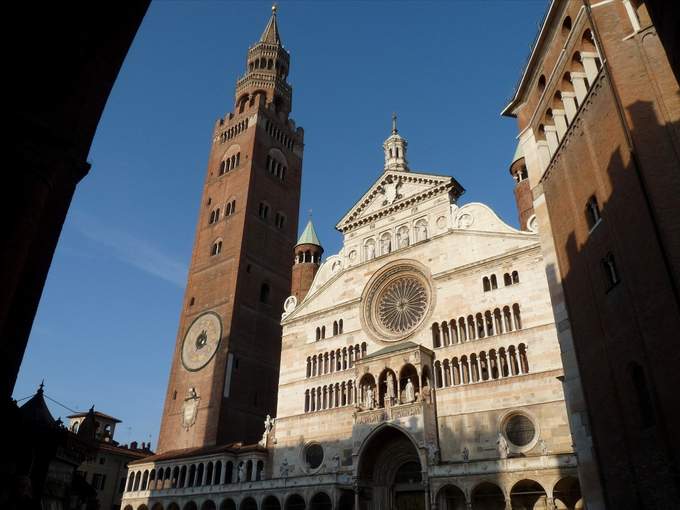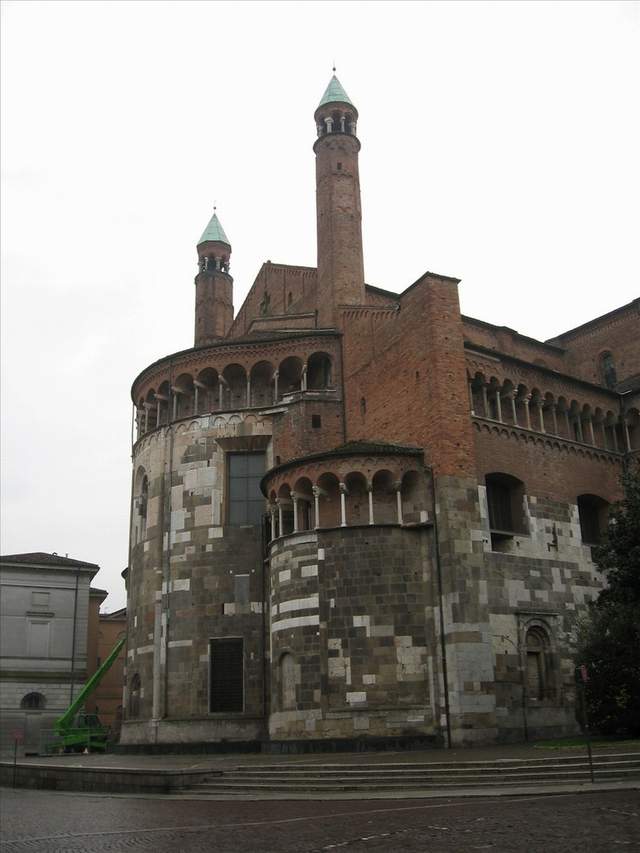| |||||
 |
The outside aspect | ||||
| Not even the precious iconographic information coming from the town hall seals reproducing the façade, can give us sure data about the structure of the façade before 1250, when it presumably had a double slope with three small crowned towers and just one entrance. | |||||
| Related images (2) |
|
THE MAIN FAÇADE Not even the precious iconographic information coming from the town hall seals reproducing the façade, can give us sure data about the structure of the façade before 1250, when it presumably had a double slope with three small crowned towers and just one entrance, but during the 13th century it was deeply changed: its profile was changed by a hut profile and crowned by 5 small towers. In 1274 the great rose-window was renewed according to the indication of the commemorative stone reporting the name of its author, the sculptor and architect Jacopo Porrata from Como. The porch in front of the actual major portal and all the façade were built in the same period and in 1283 the façade was covered with marble. This series of works regarding the façade went on together with the construction of the two planned transepts, which had been stopped for a long period, and that was carried on between the 13th and the 14th century, as the north transept is dated between 1261 and 1288, while the south transept was built between the first decades of the 14th century and 1342. At the end of the 14th century up to the last decades of the 15th century the structural plant of the building did not undergo any changes or works.
Chronicles of 1476 relate about works "pro augmentatione et fabricatione Cathedralis" (for the building and the growth of the cathedral), but the disputes arisen between the Chapter, the old ecclesiastic and administrative structure, and the Board of Trustees, the new born lay structure and expression of the municipality, delayed the beginning of these works to 1491, when the complex and final transformation of the main façade in the classical style began giving it the elegant, but composite profile that we can still admire today: from the attic with lateral volutes, the tympanum, with the papal insignia added afterwards in memory of the Bishop Nicolà Sfondrati who became pope Gregorius the 14th, to the final marble cusp. Alberto Maffiolo from Carrara was commissioned the superelevation of the façade and for the building of the marble porch called the "Bertazzola", replacing the previous one made of wood. He designed the projects but the works were carried out by Pietro da Rho, who worked at the façade from 1495 (he made the four statues in the niches of the attic and respectively representing from the left side the Saints Marcellino, Peter and Paul the Apostles, and Peter the exorcist), and Lorenzo Trotti who worked at the "Bertazzola" from 1497. This complex reform of the main façade of the cathedral was brought to end in the first two decades of the 16th century by the building, again by Trotti, of the entrance to the old Camposanto dei Canonici (Cemetery of the Canons) (1513) on the left, and the entrance to the courtyard of the Torrazzo (1514) that in 1525 was surrounded by the elegant loggia in the Bramante style. All the sculptural apparatus of the porch is noteworthy, from the full relief statues of the gallery representing Our Lady with Child at the center, and the two patron saints of the town, St Imerio Bishop and St Omobonus at her sides, all of them are works of the 14th century by Marco Romano, while the 13th century marble slab representing the Bishop Sicardo in high relief, having the function of pedestal for the statue of the Madonna, and the beautiful frieze of the months, a true calendar of stone, beating the time according to the medieval conception based on the agriculture work typical of a precise month and the relative sign of the zodiac deserve our attention. Even in the lower part of the porch that, according to the tradition, rests on the two lions by Ciambonino da Bissone (1285), there are many sculptural ornaments of the Romanesque period whose eccentric position makes us believe that they were part of the old building and here re-employed for the scarcity of marble in this area and this is also the case of the four beautiful Prophets having the function of jambs of the major portal. THE NORTH FAÇADE, THE APSES AND THE SOUTH FAÇADE This beautiful façade entirely made of bricks facing Largo Boccaccino, exteriorly defines the north transept completed in 1288 as already said; it fully reflects the standards of the Lombard gothic architecture and combines the vertical elements of the counterforts with the rich series of openings, but it also presents the insertion of the Annunciation scene, represented by the two statues of the Archangel Gabriel and the Virgin, inside two niches of the high portion of the outer counterforts (second half of the 14th century). As in the façade we find the porch resting on the lions, while the beautiful architrave of this entrance sculpted with the Traditio Legis probably belongs to the major portal of the building collapsed during the earthquake of 1117 and was here re-employed partly eliminating the two terminal statues of two apostles. If today we may admire, after overcoming the north façade, the balanced architectural ratio existing between this transept and the nave, and between this last one and apse area, we should remind that at least until the beginning of the 20th century, before the great insulation intervention, wanted and promoted by the two engineers Remo Lanfranchi and Ettore Signori, the building was almost completely surrounded by a true belt of shops, while the Antica Canonica (Hold Rectory), leant against the right minor apse and the central apse, this last rose up in largo Boccaccino. Today nothing hides the beautiful line of this part of the monument that chromatically differs from the rest of the building for its grey stone covering and whose powerful mass is lightened by the crowning gallery characterized, as is the rest of the cathedral, by the series of masks called the "impietriti" (petrified) ornating the piers of the small arches. Signs of subsequent interventions, as the closing of the beautiful central window in 1530 to which two rectangular windows were substituted in 1573, are still visible in the central apse. At the end of the short stair between the apses on the left and a wing of the bishop palace we reach the façade of the south transept that, as the other one, is entirely made of fired bricks, but due to the later period of its building in 1342, that is more than 50 years after the building of the north transept façade, it presents in a more evident way the flourished gothic style and particularly in the beautiful central four-lights window. Beyond the façade of the transept the sight sweeps over the mighty architectural structure of the nave and the joints masterly made by the anonimous medieval architects among the different parts of the building. While below a high railing defines the area of the so called Camposanto or Cimitero dei Canonici (Cemetery of the Canons), where it is possible to visit a precious floor mosaic of the 12th century, another precious remaining part of those buildings existing before the actual cathedral and whose remaining fragment of a hut building, placed almost as a guard of the narrow passage of the baptistery which brings us again in front of the main façade, is another enigmatic portion. | |
 |
Search other Guides |
Related arguments
| The Chapel of the Holy Sacrament and the Crypt |
| The Chapel of Madonna del Popolo and the altars. |
| Inside the Nave |
| The Right Aisle and the South Transept |
| The Presbytery Area |
| The outside aspect |

 Munch: The Scream Within
Munch: The Scream WithinOne of the year’s most eagerly awaited exhibitions to open its doors on 14 September 2024: Edvard Munch is back in Milan with a major retrospective after a 40-year absence.
 In the garden
In the gardenThe initiative, which is scheduled to run from June 26th to September 13th, 2020, is inaugurating a temporary space for art in Corso Matteotti 5, in Milan, in the very heart of the city.
 Perugia Travel Guide
Perugia Travel GuidePerugia is the chief town of Umbria. This beautiful town is sited on a hill in the middle of a verdant country. His central square is considered one of the most beautiful squares of Italy and history, traditions, art and nature make a unique ensemble in this town as in the whole





